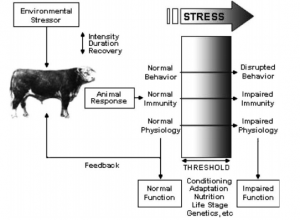
Response model for farm animals with thermal environment challenges by Hahn (1999)
All animals have a range of temperatures of which is best suited for optimal performance; if it happens that comfort zone is exceeded, it creates stress/discomfort or death on worst-case scenarios. The most probable with climate change being high ambient temperatures and humidity, leading to heat stress. Heat stress occurs when heat load exceeds the capacity to dissipate heat as a result increase rectal temperature, and respiratory rate. Whereby heat absorbed from direct solar radiation partially depends on cattle coat characteristics, where dark coats absorb more heat than light coats. However, the capability to dissipate heat is compromised when relative humidity increases with ambient temperature. If able to dissipate day heat load accordingly, cattle may acclimatize within 2-7 weeks following exposure to heat.
Heat load if not dissipated efficiently results in reduced feed intake, growth rate, fertility, milk production and increased susceptibility to diseases and parasites or even death causing a serious financial burden to cattle producers. Where extensively managed cattle is outlined to be more susceptible to heat stress than intensively (controlled environment) managed.
